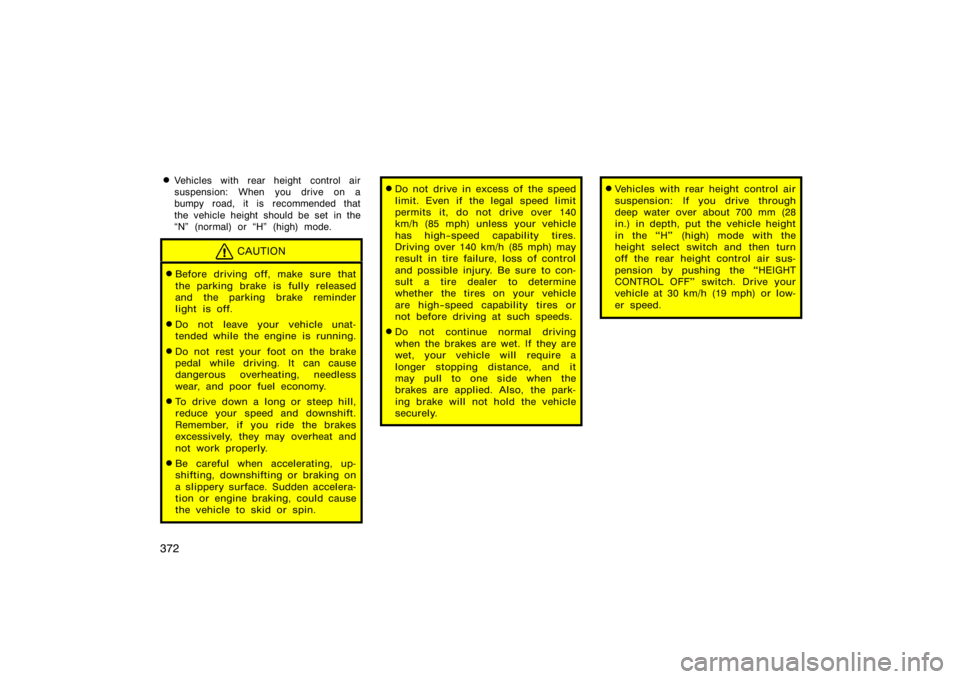Page 340 of 496
328
The cup holders are designed for hold-
ing cups or drink−cans securely.
The cup holder can be adjustable to the
size of the cups or drink−cans by
changing the holder position and the
arm position, as shown.
With the instrument panel lights on, the
front cup holder position indicator lights
will come on.
CAUTION
Do not place anything else other than
cups or drink−cans in the cup holder,
as such items may be thrown about
in the compartment and possibly in-
jured people in the vehicle during
sudden braking or in an accident.
CY19075
The rear cup holders and tray are
housed in the armrest.
The cup holders are designed to hold
cups or beverage cans securely.1. To use the rear cup holders and tray, pull the armrest out.CY19100
Rear cup holders and tray
(vehicles without third seats)
Page 342 of 496
330
CY19114
Type A (armrest)
CY19113
Type B (rear tire house)
The cup holders are designed for hold-
ing cups or drink−cans securely.
Type A�To use the holder, pull the arm-
rest out and push the lid.
CAUTION
�Do not place anything else other
than cups or drink−cans in the cup
holder, as such items may be
thrown about in the compartment
and possibly injure people in the
vehicle during sudden braking or in
an accident.
�Type A�To reduce the chance of
injury in case of an accident or
sudden stop while driving, keep the
cup holder closed when it is not in
use.
CY19015
Front doors
CY19016
Rear doors
Rear cup holders
(vehicles with third seats)Bottle holders
Page 343 of 496
331
The bottle holders are designed to hold
bottles securely.
CAUTION
Do not attempt to use the holder for
any other purpose for which it was
intended. Inappropriately sized or
shaped objects may be thrown about
in the compartment and possibly in-
jure people in the vehicle during a
sudden braking or an accident.
NOTICE
Do not put a cup or open bottle in
the bottle holder because the con-
tents may spill when the door opens
or closes.
CY19044
To secure your luggage, use the tie−
down hooks as shown above.
See ��Stowage precautions" on page 365
in Section 2 for precautions when loading
luggage.
CAUTION
To avoid personal injury, keep the tie−
down hooks folded in place on the
floor when not in use.
NOTICE
Do not use the seat anchors instead
of the tie−down hooks.
CY19076
These hooks are designed to hang
things like grocery bags.
NOTICE
To prevent damage to the hook, do
not hang any object heavier than 1 kg
(2.20 lb.) in it.
Tie−down hooksGrocery bag hooks
Page 346 of 496
334
CY19052
3. Turn the left and right knobs fromthe �UNLOCK" position to the
�LOCK" position.
Make sure the double deck is securely
locked.
CAUTION
To reduce the chance of injury in
case of an accident or sudden stop,
make sure that the double deck
knobs are always in the �LOCK" posi-
tion when the double deck is in the
raised or lowered position.
NOTICE
When using the double deck at the
raised position, do not place any ob-
ject heavier than 30 kg (66 lb.).
CY19129
Roof luggage carrier
Page 347 of 496

335
The roof luggage carrier consists of
roof rails (1) attached to the roof and
sliding cross rails (2).
To adjust the positions of cross rails, do
this.1. Turn the knobs counterclockwise to loosen the cross rails.
2. Slide the cross rails to the desired position for loading the luggages of
various sizes.
3. After adjusting, be sure to tighten the cross rails by turning knobs clockwise.
Follow the manufacturer ’s instructions and
precautions when installing the attach-
ments or their equivalent.
When there is no luggage on the roof
luggage carrier, Toyota recommends that
the front and rear cross rails be secured
in the positions indicated in the illustra-
tion, according to the following procedure.
This may diminish wind noise during driv-
ing.CAUTION
When you load cargo on the roof lug-
gage carrier, observe the following:
�Place the cargo so that its weight
is distributed evenly between the
front and rear axles.
�If loading long or wide cargo, never
exceed the vehicle overall length or
width. (See �Dimensions and
weights" on page 462 in Section 8
for information on your vehicle
overall length and width.)
�Before driving, make sure the cargo
is securely fastened on the roof
luggage carrier.
�Loading cargo on the roof luggage
carrier will make the center of the
vehicle gravity higher. Avoid high
speeds, sudden starts, sharp turns,
sudden braking or abrupt maneu-
vers, otherwise it may result in loss
of control or vehicle rollover due to
failure to operate this vehicle cor-
rectly.
�If driving for a long distance, on
rough roads, or at high speeds,
stop the vehicle now and then dur-
ing the trip to make sure the cargo
remains in its place.
�Do not exceed 54 kg (120 lb.) cargo
weight on the roof luggage carrier.
NOTICE
When loading the luggages, be careful
not to scratch the surface of the
moon roof.
Page 374 of 496
362Ti r e relat ed ter m
Meaning
Snow tire
a tire that attains a traction index equal
to or greater than 110, compared to
the ASTM E−1136 Standard Reference Test Tire, when using the snow traction
test as described in ASTM F−1805−00, Standard Test Method for Single Wheel
Driving Traction in a Straight Line on Snow−and Ice−Covered Surfaces, and
which is marked with an Alpine Symbol ( ) on at least one sidewall
Te s t r i mthe rim on which a tire is fitted for testing, and may be any rim listed as appropri-
ate for use with that tire
Treadthat portion of a tire that comes into contact with the road
Tread riba tread section running circumferentially around a tire
Tread separationpulling away of the tread from the tire carcass
Treadwear indicators(TWI)the projections within the principal grooves designed to give a visual indication
of the degrees of wear of the tread
Wheel−holding fixturethe fixture used to hold the wheel and tire assembly securely during testing
Page 378 of 496

366�
Do not place anything on the
luggage cover. Such items may
be thrown about and possibly
injure people in the vehicle
during sudden braking or an
accident. Secure all items in a
safe place.
� Do not drive with objects left
on top of the instrument panel.
They may interfere with the
driver’s field of view. Or they
may move during sharp vehicle
acceleration or turning, and im-
pair the driver’s control of the
vehicle. In an accident they
may injure the vehicle occu-
pants.
Cargo capacity depends on the to-
tal weight of the occupants.
(Cargo capacity) = (Total load capac-
ity) – (Total weight of occupants)
Steps for Determining Correct
Load Limit�
(1) Locate the statement �The com-
bined weight of occupants and
cargo should never exceed XXX
kg or XXX lbs." on your vehicle’s
placard.
(2) Determine the combined weight of the driver and passengers that
will be riding in your vehicle.
(3) Subtract the combined weight of the driver and passengers from
XXX kg or XXX lbs. (4) The resulting figure equals the
available amount of cargo and
luggage load capacity. For exam-
ple, if the � XXX" amount equals
1400 lbs. and there will be five
150 lb passengers in your ve-
hicle, the amount of available
cargo and luggage load capacity
is 650 lbs. (1400–750
(5x150)=650 lbs.)
(5) Determine the combined weight of luggage and cargo being
loaded on the vehicle. That
weight may not safely exceed the
available cargo and luggage load
capacity calculated in Step 4.
(6) If your vehicle will be towing a trailer, load from your trailer will
be transferred to your vehicle.
Consult this manual to determine
how this reduces the available
cargo and luggage load capacity
of your vehicle.
For details about trailer towing, see
page 377.
� C ap acit y an d dist rib u t io n
Page 384 of 496

372�
Vehicles with rear height control air
suspension: When you drive on a
bumpy road, it is recommended that
the vehicle height should be set in the
�N" (normal) or �H" (high) mode.
CAUTION
�Before driving off, make sure that
the parking brake is fully released
and the parking brake reminder
light is off.
�Do not leave your vehicle unat-
tended while the engine is running.
�Do not rest your foot on the brake
pedal while driving. It can cause
dangerous overheating, needless
wear, and poor fuel economy.
�To drive down a long or steep hill,
reduce your speed and downshift.
Remember, if you ride the brakes
excessively, they may overheat and
not work properly.
�Be careful when accelerating, up-
shifting, downshifting or braking on
a slippery surface. Sudden accelera-
tion or engine braking, could cause
the vehicle to skid or spin.
�Do not drive in excess of the speed
limit. Even if the legal speed limit
permits it, do not drive over 140
km/h (85 mph) unless your vehicle
has high−speed capability tires.
Driving over 140 km/h (85 mph) may
result in tire failure, loss of control
and possible injury. Be sure to con-
sult a tire dealer to determine
whether the tires on your vehicle
are high−speed capability tires or
not before driving at such speeds.
�Do not continue normal driving
when the brakes are wet. If they are
wet, your vehicle will require a
longer stopping distance, and it
may pull to one side when the
brakes are applied. Also, the park-
ing brake will not hold the vehicle
securely.
�Vehicles with rear height control air
suspension: If you drive through
deep water over about 700 mm (28
in.) in depth, put the vehicle height
in the �H" (high) mode with the
height select switch and then turn
off the rear height control air sus-
pension by pushing the �HEIGHT
CONTROL OFF" switch. Drive your
vehicle at 30 km/h (19 mph) or low-
er speed.